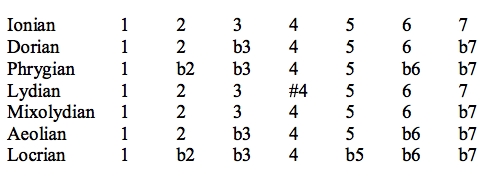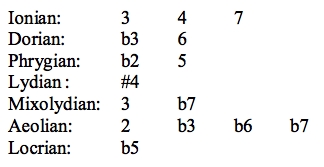This article assumes you have a good basic knowledge of music theory. If you don't, you can check out my free eBook on my website, "An Introduction to Music Theory" for guitar players.
Before we get started, we need to quickly revise the modes and what makes each of them unique:

So the intervals that make each mode unique:

Now to make our chords sound more interesting, and also to help set a particular mode, we add these unique intervals to our chords. Let's take the chord A minor as an example. Say we wanted to give it a Dorian feel. We already have the b3 in the chord (as it is a minor chord), so we can add the 6, which would be an F#:

These chords have some interesting sounds!
Let's do the same thing with A major and give it a Lydian sound. To do this we need to add a #4 into the chord - an D#:

As you can see, we start to develop some very awkward chord shapes... but we do get some great sounds! Rather than memorizing these chord shapes, learn the principles used to create them, so you can add chords like this into your playing whenever you want to.
With a decade of playing under his belt, Sam Russell has been pretty busy with his guitar playing. Attending BIMM after university to study music, Sam then went on to study with Tom Hess and Luca Turilli while teaching guitar in West London.
Russell has also been attending workshops with Bumblefoot and Ola Englund and recently played with Steve Vai, as well as releasing three books - Bach's first 3 cello suites for electric guitar (suites 4-6 coming out early 2015).
He has recently published an eBook: "The Ultimate Guide to the Modes of the Major, Harmonic Minor and Melodic Minor Scale", which you can get for free here.